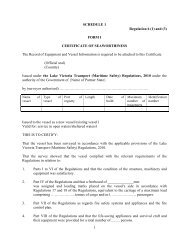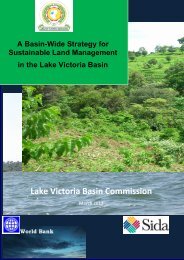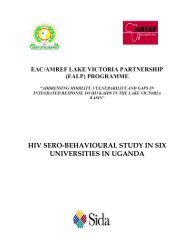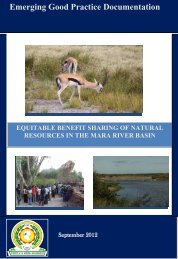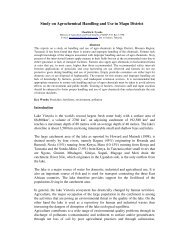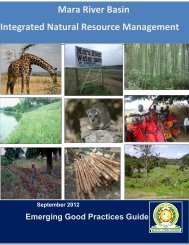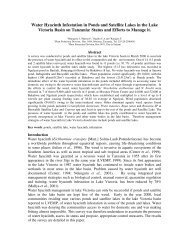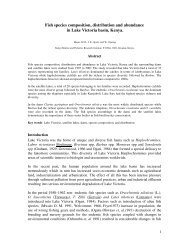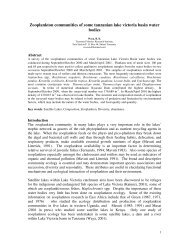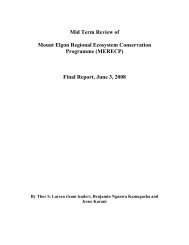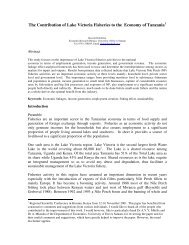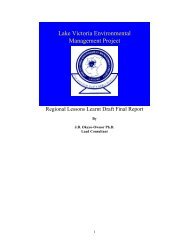Total Economic Value of Maasai Mau, Trans Mara and Eastern Mau ...
Total Economic Value of Maasai Mau, Trans Mara and Eastern Mau ...
Total Economic Value of Maasai Mau, Trans Mara and Eastern Mau ...
Create successful ePaper yourself
Turn your PDF publications into a flip-book with our unique Google optimized e-Paper software.
the river. Because we did not obtain data on the capacity <strong>of</strong> the water project underconstruction, we assumed that the Sigor water project would provide water to apopulation equal to that <strong>of</strong> Narok town. The water supply to Narok town was thusused as a proxy for measuring the water dem<strong>and</strong> in the Nyangores River. The twomajor urban centres <strong>of</strong> Narok <strong>and</strong> Bomet respectively consume about 18,000m 3 <strong>and</strong>6000m 3 <strong>of</strong> water per day. Thus, the annual dem<strong>and</strong> for water by the population is8,760,000m 3 . With a price <strong>of</strong> KES 200 for the first 6m 3 or KES 33.3 per cubic metre, theurban centres will accumulate KES 291,708,000 (US$ 3,889,440) as gross annual revenue.The total cost <strong>of</strong> running a borehole for a year is given in Table 6.Table 6: <strong>Total</strong> annual cost <strong>of</strong> running a boreholeHouseholds Livestock Irrigation MiningProportion <strong>of</strong> the total dem<strong>and</strong> 20 17 51 3dem<strong>and</strong> for water (m 3 ) 4,800,000 4,080,000 12,240,000 720,000Number <strong>of</strong> boreholes 1,753 1,490 4,470 263Cost <strong>of</strong> constructing a borehole 21,185 21,185 21,185 21,185<strong>Total</strong> cost <strong>of</strong> boreholes 37,139,518 31,568,590 94,705,771 5,570,928Annual cost <strong>of</strong> boreholes (US$) 1,237,984 1,052,286 3,156,859 185,698Annual cost <strong>of</strong> borehole maintenance 1,994 1,994 1,994 1,994<strong>Total</strong> annual cost <strong>of</strong> running a borehole 1,239,978 1,054,280 3,158,853 187,6923.4 Forest Functions for Soil Conservation <strong>and</strong> Water RegulationForests play a major role in soil <strong>and</strong> water conservation, particularly regulation <strong>of</strong> waterflows <strong>and</strong> control <strong>of</strong> floods <strong>and</strong> erosion. Currently, there is scanty information <strong>and</strong> datato enable quantification <strong>of</strong> the contribution <strong>of</strong> forests to soil stabilization <strong>and</strong> waterregulation in the upper catchment areas <strong>of</strong> Kenya. Soil erosion is affected by manyfactors including rain intensity <strong>and</strong> periodicity, soil type, slope, vegetation cover <strong>and</strong>agricultural practices prevailing in the site. It was not possible to estimate the soilconservation functions <strong>of</strong> the forests due to lack <strong>of</strong> quantitative data <strong>and</strong> hence the usebenefit transfer method. Langat <strong>and</strong> Cheboiwo (2010) used data <strong>and</strong> information fromFAO/IISA (1991) to evaluate the potential protective cover <strong>of</strong> Tindiret Forest ascompared to l<strong>and</strong> under maize crop using the yield loss method. Tindiret Forest is part<strong>of</strong> <strong>Mau</strong> Forest Complex so similarity is assumed that justified the use the method toestimate values for the forest blocks.Key assumptions for estimation <strong>of</strong> soil conservation values were the natural forestshave at least 50mm <strong>of</strong> litter layer <strong>and</strong> canopy <strong>of</strong> 75% with 90% <strong>of</strong> the area covered by at35



